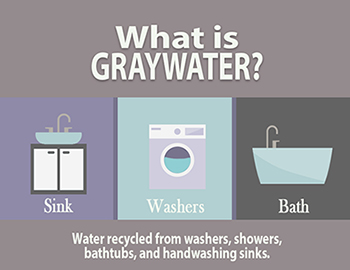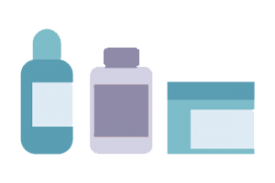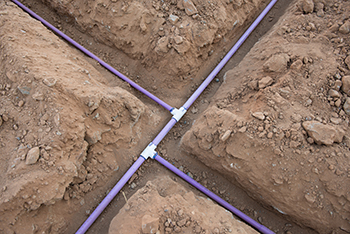Graywater, From Your Sink To Your Lawn
![]() You may have heard about graywater, but are unsure what it is. Graywater is simply wastewater that can be recycled. Some may think this sounds strange, but water reuse has many benefits. Recycling water can…
You may have heard about graywater, but are unsure what it is. Graywater is simply wastewater that can be recycled. Some may think this sounds strange, but water reuse has many benefits. Recycling water can…
![]()
You may have heard about graywater, but are unsure what it is. Graywater is simply wastewater that can be recycled. Some may think this sounds strange, but water reuse has many benefits. Recycling water can:
save water, energy, and money,
conserve potable water for drinking, bathing, etc.,
provide a dependable, locally controlled water supply, and
reduce the diversion of water from sensitive ecosystems.
This article provides an overview of graywater use by homeowners. It does not replace laws and regulations of the state or the Texas Commission on Environmental Quality, which take precedence over any information contained herein.
In addition, local permitting authorities may have more stringent requirements. See the TCEQ publication Graywater and Alternative On-site Water: A Guide for Homeowners for more information.
 WHAT IS GRAYWATER?
WHAT IS GRAYWATER?
Graywater is wastewater that can be recycled from clothes washers, showers, bathtubs, hand-washing lavatories, and sinks that are used for disposal of household products. Graywater also includes water from sinks that are not used for food preparation or disposal.
WHAT IS NOT GRAYWATER?
Graywater does not include water that has come in contact with human waste or water from sinks used for food preparation or disposal.
HOW IS GRAYWATER USED?
Recycled water can satisfy many water demands. Graywater can be used at a residence for the following purposes:
- to minimize foundation movement or cracking,
- for gardening,
- for composting,
- for landscaping, and
- for toilet flushing
There are also commercial, industrial, institutional, and agricultural uses for graywater.
HOW DOES GRAYWATER REUSE HELP THE ENVIRONMENT?
 Recycling Water Can Save Energy
Recycling Water Can Save Energy
As the demand for water grows, more water must be extracted, treated, and transported, sometimes over great distances. Recycling water on-site or nearby reduces the energy needed to move water or pump water from an aquifer. It takes energy to treat water and reusing graywater reduces the amount of treated water we need in our homes.
 Recycled Water Can Reduce the Need for Supplemental Fertilizers
Recycled Water Can Reduce the Need for Supplemental Fertilizers
Recycled water may contain higher levels of nutrients, such as nitrogen, than potable water. Using recycled water to irrigate your landscape can provide an additional source of nutrients and lessen the need to apply synthetic fertilizers.
 Water Recycling Can Help Ecosystems
Water Recycling Can Help Ecosystems
Plants, wildlife and fish depend on a certain level of water flow to their habitats. Sometimes when water is diverted for agricultural, urban, and industrial purposes, this reduces the water flow in waterways and can compromise water quality. Recycled water can free up considerable amounts of water, increasing flow to vital ecosystems.
 HOW DO I DESIGN AND OPERATE A REUSE SYSTEM?
HOW DO I DESIGN AND OPERATE A REUSE SYSTEM?
The design and operation of a reuse system depends on numerous factors such as the size of your system, whether your system contains only graywater or also contains other allowable types of water, and whether the graywater is generated at a private residence, a commercial, industrial, or institutional facility, or an agricultural facility.
See the TCEQ publication Graywater and Alternative On-site Water: A Guide for Homeowners for more information.
Recommendations and Best Management Practices
- To minimize environmental impacts, avoid laundry detergents containing phosphorus, sodium, or boron, or choose detergents with less of these ingredients. Product ingredients are listed on the labels in descending order, so those listed lower on the label are present in smaller quantities.
- Graywater can contain bacteria, so minimize contact with the water from your reuse system. Use precautions to prevent children and pets from contacting reused water.
- To protect your drinking water from contamination, check for accidental connections between your reuse system and your potable water supply.
- It is recommended that you use established plumbing and treatment standards to comply with Texas rules and to ensure that your reuse system functions properly.
- Before constructing a reuse system, consult with your local permitting authority (typically either the city or county) and qualified individuals in your area to determine if there are additional requirements, recommendations or best management practices applicable in your region of the state.
- Ensure that you receive adequate guidance from the designer of your reuse system to operate and maintain your system in compliance with state and local requirements.
*Graphics and source: Texas Commission on Environmental Quality/TakeCareofTexas.org.







We have a greywater system from our washing machine that has virtually saved our yard on the right side of our house. Wish we could do one from our dishwasher to the left side of our house, but it is associated with the kitchen sink and garbage disposal. So that is not possible. Thank you for this article to bring this source of water to people’s attention.